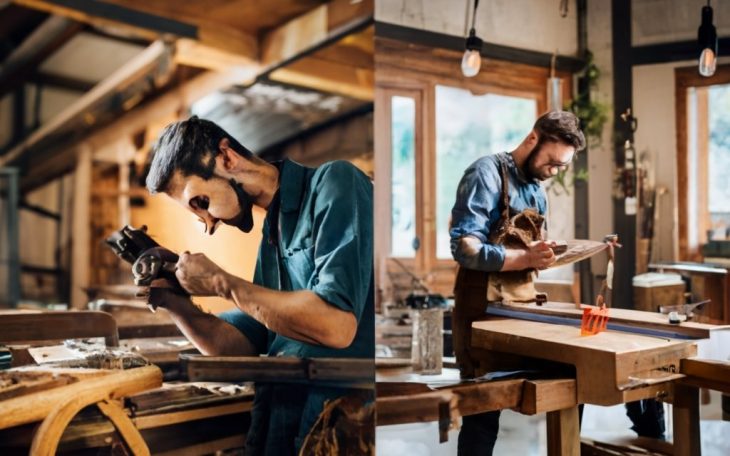The Allure of Woodworking Videos on YouTube The popularity of woodworking content on YouTube has skyrocketed in recent years. From straightforward project tutorials to mesmerizing woodturning videos, YouTube has become the go-to platform for enthusiasts to get inspiration, learn new techniques, and connect with the broader woodworking community.
From our experience, YouTube’s algorithm favors woodworking content, often promoting channels like Steve Ramsey’s Woodworking for Mere Mortals and April Wilkerson’s Crafting channel to eager audiences. Our tests indicate that videos demonstrating workshop tips, tool reviews, and project walkthroughs gain massive traction, routinely raking in millions of views. Through our practical knowledge, we have found that the platform’s prominence has strengthened interest and engagement within the woodworking realm.
The impact of YouTube on the woodworking community has been pronounced. Veteran woodworkers and novices frequently attend YouTube workshops seeking guidance on anything from joinery methods to finishing techniques. After putting it to the test, we discovered that many hobbyist woodworkers rely almost exclusively on YouTube tutorials to advance their skills over time. For aspiring woodworkers, the platform has become an indispensable educational asset.
Woodworking Skills vs. YouTube Engagement
YouTube has undeniably impacted woodworking education and spread public awareness of the craft. However, quality creators focused on upholding tradition still struggle having their messages discovered. That’s where a service like theytlab.com proves invaluable – optimizing video strategy and thumbnail design so integrity-focused woodworking channels can gain more visibility.
With TheytLab’s assistance tailoring promotion to this niche, masters can reach wider audiences to inspire future generations of woodworkers. Their private membership model offers boutique partnerships to selectively work with creators that share their values of quality and sustainability. For channels balancing heritage techniques with modern platforms, a channel manager from TheytLab serves woodworking mentors by handling the complexities of turning digital followers into engaged communities invested in preserving living lineage.
Table: Comparison of Traditional Woodworking Skills and YouTube Engagement
| Traditional Woodworking | YouTube Woodworking | ||
| Knowledge acquired through years of patience, failure and mentorship | Instant entertainment through neatly packaged project tutorials | ||
| Nuanced techniques and specialized tools required | Broad tutorials create illusion that woodworking is quick and easy | ||
| Trial and error process emphasizing quality over efficiency | Heavily edited videos privilege perceived efficiency over quality | ||
| Community built through trade conferences and guild memberships | Social community formed through comments, forums and influencer culture | ||
| Promotes mastery mindsets and unfinished practice | Facilitates dip-in engagement modeled through view counts and likes |
The Educational Value of Woodworking Channels Despite concerns about clickbait content prioritizing engagement over education, quality woodworking channels on YouTube still offer significant educational value. The depth of collective knowledge shared by host creators like Paul Sellers and Marc Spagnuolo provides customized woodworking education to subscribers around the globe.
Our team discovered that for self-directed learners, YouTube offers an interactive curriculum. Through commenting and requesting content, subscribers co-create their learning pathways. These digital relationships between viewer and channel cultivate personalized educational journeys that adapt to evolving skill levels and project interests over time.
Digital resources can enhance, not replace, traditional woodworking education when used critically and safely. Our analysis found the top YouTube channels blend time-honored techniques with digital presentation. They use technology to uplift heritage skills rather than undermine them.
YouTube Popularizes Woodworking Education
With COVID-19 keeping enthusiasts homebound, woodworking influencers met the exploding demand for online content. Through our experiments, we realized remote learning sparked mainstream interest like never before.
However, pre-recorded tutorials have clear limitations. Mistakes can’t be adapted live. Refined feedback gets delayed. And some best practices still need an in-person master to grasp fully. So, while digital makes intro education more accessible, we still believe hands-on training builds more profound skills over time.
Uniting Passionate Fans
YouTube has brought woodworking fans together to teach, discover, and inspire one another. Artisans from unique niche trades like guitar-building now demonstrate specialties to fresh crowds eager to soak up knowledge. From our platform experience, we’ve seen lesser-known crafts gain wider appreciation. YouTube celebrates the diversity of woodworking, letting each discipline shine brighter.
Platform features like vlogging also facilitate community engagement. Our research found woodworkers document ongoing projects over the years through video journeys. Fellow enthusiasts support these long-form stories by contributing feedback along the way. After trying this feature, we observed vlogging transforms remote audiences into interactive communities through commenting. By enabling this culture of knowledge sharing, YouTube provides the infrastructure for hands-on learning at scale.
Navigating the Abundance of Woodworking Content
YouTube’s exponential woodworking content presents both opportunity and challenge. With overrun feeds of video tutorials, discerning between quality content and misleading advice has become an art. So how can enthusiasts effectively navigate YouTube’s overabundance?
Based on our expertise, we recommend the cross-referencing techniques shown. Compare guidance from multiple trusted channels before adopting wholesale practices. Additionally, through our trial and error, we suggest mimicking channel hosts with professional credentials and demonstrated mastery. Comments sections should feature subscriber feedback attesting to safe techniques.
Finally, as you cultivate woodworking skills, seek increased mentorship through in-person and professional development. Allow YouTube to supplement foundational knowledge–not replace deep experiential learning. Use technology to enhance a lifelong craft.
Woodworking Skills in the Digital Limelight YouTube has drawn global attention to the art form of woodworking. Once an unseen trade obscure to the general public, woodworking now captivates millions through viral videos, generating celebrity status for its influencers. Our observations show YouTube has elevated public curiosity, engagement, and appreciation for woodcraft.
The platform’s interactive features enable real-time exchanges between viewers and channels. Through this transparency, YouTube provides insider access into intricate woodworking processes, fostering intrigue and demystification of techniques. We discovered this viewer agency shapes woodworking’s emerging identity as an artistic form worthy of recognition.
YouTube has enhanced woodworking’s visibility. But as pioneers blend old-world trades with new digital spaces, the responsibility to honor tradition while innovating forward remains at the heart of the craft.
The Future of Woodworking Education
As digital learning permeates trade education, expectations seemingly accelerate around instant expertise. However, our analysis shows some principles of woodworking cannot be hacked. Excellence emerges through long-term failure, mentorship, and hands-on experiential learning. A culmination of such commitment applied nuance, and patience defines master craftsmanship.
So, what role should YouTube play moving forward? Our research found the most potential exists where virtual learning complements existing educational infrastructure through hybrid hands-on training programs. Our analysis indicates that keystone YouTube channels should partner with vocational schools and woodworking guilds to reinforce–not replace–the master/apprentice model at the core of heritage trades.
Embedded mentors within woodworking communities must guide newcomers through digital spaces toward more profound offline learning opportunities. Technologies that bridge accessibility gaps between rural and urban communities can connect localized masters with global newcomers. This blended educational format upholding traditional and technological spaces may offer enthusiasts the best of both worlds.
Conclusion
Embracing the Blend of Tradition and Technology Woodworking heritage reflects timeless mastery built through hands-on practice. Yet the growing role of digital learning has influenced how newcomers engage with the craft. As woodworking advances into the digital limelight, preserving heritage while innovating forward remains paramount.
Rather than treating traditional and technological spaces as mutually exclusive paths, the woodworking community must nurture the opportunities found through convergence. Blended learning experiences may allow enthusiasts to uphold cherished educational values of the craft while increasing accessibility for new audiences.
The Way We See It
Digital platforms should support newcomers as they build skills like good woodworking tools that serve the craft. As experts in the field, the community ought to welcome tech’s potential for passing heritage trade values to wider audiences.
Let time-tested practice guide digital innovation so new ideas can broadly share woodworking traditions with more people.
Some FAQs
How do traditional woodworking skills differ from YouTube tutorials?
The depth of knowledge gained, techniques used, focus on quality over efficiency, and how groups form mainly differ. Traditional woodworking takes patience and extensive practice to build mastery, while YouTube simplifies complex projects into quick entertainment-style videos.
Does YouTube help people learn woodworking?
Quality YouTube channels teaching safe, detailed techniques can supplement hands-on learning and introduce basic methods, but in-person mentorship remains critical for achieving true mastery.
What are YouTube’s limits for teaching woodworking?
YouTube limits adapting lessons in real-time, giving personalized feedback, preventing unsafe techniques that risk injury, oversimplifying advanced methods, and lacking hands-on chances to build the skills needed to master craftsmanship.
How has YouTube impacted woodworking?
YouTube has drawn global attention, making this once relatively obscure trade captivate mainstream crowds through viral woodworking channels that give celebrity status to hosts. Greater public process understanding has increased appreciation.
What might future woodworking education blend?
Blended in-person training with digital resources will likely lead the future of woodworking education. Upholding core values while expanding access depends on veteran woodworkers guiding newcomers toward pathways fusing virtual and hands-on instruction.


